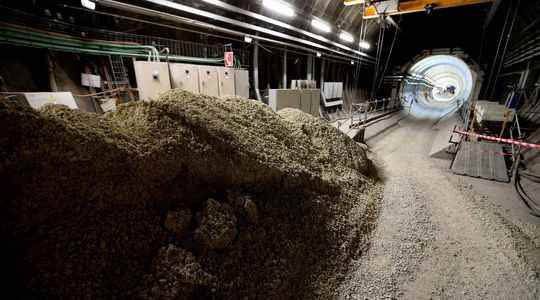It’s a rather special treasure hunt that Javier Escartin and Patrick Chardon have been preparing for several years. By 2024, these two scientists attached respectively to the Institute of Earth Physics and the Clermont Physics Laboratory, will lead an expedition on the trail of radioactive waste immersed in the Atlantic. Between 1940 and 1973, no less than 200,000 barrels of waste were dumped there by nations such as France, the United Kingdom and the United States.
“The objective of our mission is to map and sample the areas close to this waste to understand the impact they have had on this environment”, explains Javier Escartin. The ocean, radioactive trash? Unimaginable these days. “In the 1930s and 1940s, there was a lack of knowledge about the means of managing or storing this waste”, tries to put the researcher into perspective.
Things have evolved a lot since then. In 1991, French law paved the way for a debate around the storage of waste on the surface or at shallow depth, a solution sometimes defended by activists of the anti-nuclear cause. In an opinion issued in 2006, the Nuclear Safety Authority challenged this proposal, judging that long-term storage could not “constitute a definitive solution”. The idea of storing the waste at a depth of 500 meters was finally adopted at the Industrial Geological Storage Center (Cigeo) in Bure, in the Meuse. But the scientists have not said their last word. New options are now being considered.
Transmutation
Alchemists dreamed of turning lead into gold. Scientists are seriously considering modifying the structure of certain nuclear waste and thus reducing the duration of their radioactivity by 1000. “The idea of this transmutation was born four or five years ago. It is based in particular on the work of the French physicist Gérard Mourou”, specifies Franck Leibreich, director of laser solutions at Thales. Its principle? Bombard the fission residue using very high intensity lasers. The pulse will trigger a chain reaction capable of transforming long-lived radioactive elements into shorter-lived elements.
“Thanks to the technique invented by Gérard Mourou and Donna Strickland, who won the Nobel Prize in 2018, we can produce lasers of considerable power, which makes transmutation possible today”, explains Frank Leibreich. Of course, there are still many technological barriers to overcome. The treatment of waste by laser would in particular require the construction of a facility similar in size to that of a nuclear power plant.” But in the Thales laboratories in Romania, experiments are going well.
“Be careful not to idealize this solution, however, confides an expert from the National Agency for Radioactive Waste Management (Andra). It remains interesting for certain fission products because they give off a lot of heat, which complicates storage. But do not believe that we will solve all waste problems in this way. In the past, transmutation has sometimes been presented as an alternative to disposal. In fact, it would rather be a complementary solution .”
A waste-eating AMR
This is perhaps the most realistic solution in the medium term: an AMR (for “Advanced Modular Reactor“) capable of ingesting large quantities of waste. The French start-up Naarea is already working on the design of a 40 megawatt prototype. “This fourth-generation reactor, called “molten salts”, will operate differently from our systems pressurized water currents”, warns Joël Guidez, scientific adviser of the company. Inside, instead of being slowed down by the water, the neutrons will keep all their energy there, allowing the waste to be burned.
If these reactors multiplied, we could draw on the stocks of plutonium resulting from reprocessing and on those of depleted uranium, a by-product of enrichment operations without which our current power stations could not operate. This would reduce our volume of waste because France produces 10 tons of plutonium every year. Its reserves of depleted uranium exceed the threshold of 300,000 tonnes. France has already experimented with this type of technology in the past with its Phénix and Superphénix reactors. Sodium-cooled, these operated with 20% plutonium and 80% depleted uranium. “With a molten salt reactor, the principle remains the same. But the great advantage of these fast neutron facilities lies in their ability to manufacture as much or even more fissile material than they consume”, specifies Joël Guidez.
Refueling is also much simpler. Better: with molten salt AMR, there can be no explosion in the installation. “In a conventional power plant, the excessive rise in temperature of the core leads to interactions with the coolant. There is then production of hydrogen, which can lead to an accident. A reaction impossible in our reactor because the core is already Environment, reloading, safety… the AMR therefore wins on all counts. Or almost. “Its only fault is its price, slips an expert. Superphénix worked well before being stopped in 1997. But it had cost 2.2 times the price of a reactor corresponding to water.” By counting on a lower power, Naarea hopes to ward off fate.
Send the trash into the Sun
“That’s the first thing I asked when I discovered the subject. Why don’t we send this waste to disintegrate in the Sun, which is after all the largest of nuclear reactors!”, told us recently an executive from the Institute for Radiation Protection and Nuclear Safety. A not so crazy idea. NASA itself even considered it in the 1970s. Before changing its mind. And for good reason !
“Without even thinking about the money it will cost, the risk of a rocket burning in the atmosphere and losing this waste en route makes it inconceivable today,” explains Bernd Grambow, professor emeritus of radiochemistry. The conquest of space and the billions invested by the Musks, Bezos and associates may tomorrow make it possible to reduce costs and ensure safety for the transfer of this waste to space. But for now, nothing is less certain.
